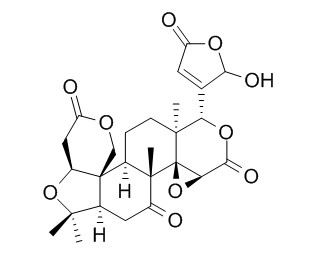Limonexic acid
Limonexic acid shows antinociceptive actions , it produces dose-related inhibition of glutamate- and capsaicin-induced pain. Limonexic acid can effectively protect hepatocyte against CCl4-induced injury.
Inquire / Order:
manager@chemfaces.com
Technical Inquiries:
service@chemfaces.com
Tel:
+86-27-84237783
Fax:
+86-27-84254680
Address:
1 Building, No. 83, CheCheng Rd., Wuhan Economic and Technological Development Zone, Wuhan, Hubei 430056, PRC
Providing storage is as stated on the product vial and the vial is kept tightly sealed, the product can be stored for up to
24 months(2-8C).
Wherever possible, you should prepare and use solutions on the same day. However, if you need to make up stock solutions in advance, we recommend that you store the solution as aliquots in tightly sealed vials at -20C. Generally, these will be useable for up to two weeks. Before use, and prior to opening the vial we recommend that you allow your product to equilibrate to room temperature for at least 1 hour.
Need more advice on solubility, usage and handling? Please email to: service@chemfaces.com
The packaging of the product may have turned upside down during transportation, resulting in the natural compounds adhering to the neck or cap of the vial. take the vial out of its packaging and gently shake to let the compounds fall to the bottom of the vial. for liquid products, centrifuge at 200-500 RPM to gather the liquid at the bottom of the vial. try to avoid loss or contamination during handling.
J Nat Med.2021, doi: 10.1007.
Plants2022, 11(3),294.
Horticulture Research2022, uhac276.
Evid Based Complement Alternat Med.2015, 2015:165457
Nutrients.2024, 16(7):965.
J Agric Food Chem.2021, 69(11):3496-3510.
Phytother Res.2019, 33(7):1784-1793
Front Pharmacol.2019, 10:1025
Anticancer Res.2021, 41(3):1357-1364.
J Ethnopharmacol.2020, 254:112733.
Related and Featured Products
Food Chem Toxicol. 2013 Dec;62:432-5.
Protective effect of compounds from the flowers of Citrus aurantium L. var. amara Engl against carbon tetrachloride-induced hepatocyte injury.[Pubmed:
23985451]
5-Hydroxy-6,7,3',4'-tetramethoxyflavone (HTF), Limonexic acid (LA) are two compounds isolated from the flowers of Citrus aurantium L. var. amara Engl with various biological activities.
METHODS AND RESULTS:
This study was designed to investigate their protective effects against carbon tetrachloride (CCl4)-induced hepatocyte injury, using human hepatic cell line HL-7702 to determine the cell cytotoxicity, cell viability, levels of hepatic marker enzymes, malondialdehyde (MDA). Results showed that pretreatment with HTF, Limonexic acid could significantly reverse CCl4-induced HL-7702 cell viability decrease, Limonexic acid displayed a higher activity. HTF, Limonexic acid also showed their capability of decreasing the CCl4-induced leakage of lactate dehydrogenase (LDH), aspartate aminotransferase (AST), inhibiting the lipid peroxidation, HTF showed more significant activity.
CONCLUSIONS:
Given that HTF, Limonexic acid were not toxic, it is concluded that HTF, Limonexic acid could effectively protect hepatocyte against CCl4-induced injury.
J Pharm Pharmacol. 2007 Nov;59(11):1573-81.
Antinociceptive action of limonexic acid obtained from Raulinoa echinata.[Pubmed:
17976270]
The antinociceptive effect of the Limonexic acid isolate of Raulinoa echinata Cowan in four models of pain in mice is described.
METHODS AND RESULTS:
When evaluated against acetic acid-induced abdominal constrictions, Limonexic acid (10, 30 and 60 mg kg(-1), i.p.) produced dose-related inhibition of the number of constrictions, with a mean ID50 value of 43 (2.3-79) micromol kg(-1), and was more potent than some standard drugs. In the formalin test, Limonexic acid inhibited both the first and second phases of formalin-induced pain. Furthermore, the effect was more pronounced in the second phase, with a mean ID50 value of 13.66 (9.35-19.61) micromol kg(-1), and had a pharmacological profile that was similar to standard drugs such as acetaminophen and acetyl salicylic acid. Limonexic acid also produced dose-related inhibition of glutamate- and capsaicin-induced pain, with mean ID50 values of 11.67 (8.51-16.0) micromol kg(-1) and 47.17 (36.51-60.93) micromol kg(-1), respectively.
CONCLUSIONS:
The mechanism of action is not completely understood, but seems to involve direct interaction with the GABAergic and nitroxidergic pathways.
Food Funct. 2013 Feb;4(2):258-65.
Limonoids and their anti-proliferative and anti-aromatase properties in human breast cancer cells.[Pubmed:
23117440]
Lemons are a widely used citrus crop and have shown several potential health benefits. In the present study, the mechanism and effectiveness of the anti-cancer and anti-aromatase properties of limonoids were investigated for the first time. Defatted lemon (Citrus lemon L. Burm) seed powder was extracted with ethyl acetate (EtOAc) and methanol (MeOH) for 16 h each, successively.
METHODS AND RESULTS:
These extracts were fractionated using 1D (silica) and 2D (ion exchange and SP-70 columns) column chromatography to obtain nine limonoids.
The compounds were identified by TLC, HPLC, and LC-MS techniques. A panel of 9 purified limonoids, including limonin, nomilin, obacunone, Limonexic acid (LNA), isoLimonexic acid (ILNA), nomilinic acid glucoside (NAG), deacetyl nomilinic acid glucoside (DNAG), limonin glucoside (LG) and obacunone glucoside (OG) as well as 4 modified compounds such as limonin methoxime (LM), limonin oxime (LO), defuran limonin (DL), and defuran nomilin (DN), were screened for their cytotoxicity on estrogen receptor (ER)-positive (MCF-7) or ER-negative (MDA-MB-231) human breast cancer cells. We further tested the mechanism of the anti-proliferative activity of limonoids using an in vitro aromatase enzyme assay and western blot with anti-caspase-7. Among the tested limonoids, 11 limonoids exhibited cytotoxicity on MCF-7 whereas 8 limonoids showed cytotoxicity against the MDA-MB-231 cell lines. Although most of the limonoids showed anti-aromatase activity, the inhibition of proliferation was not related to the anti-aromatase activity. On the other hand, the anti-proliferative activity was significantly correlated with caspase-7 activation by limonoids.
CONCLUSIONS:
Our findings indicated that the citrus limonoids may have potential for the prevention of estrogen-responsive breast cancer (MCF-7) via caspase-7 dependent pathways.



